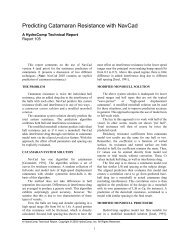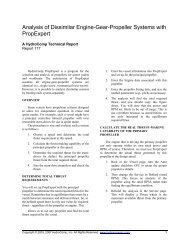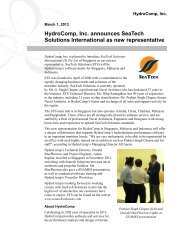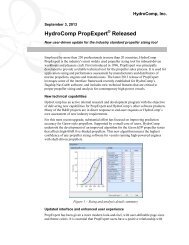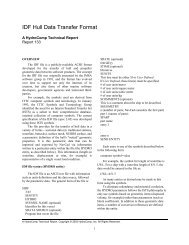Small Propeller Cup: - Hydrocomp Inc.
Small Propeller Cup: - Hydrocomp Inc.
Small Propeller Cup: - Hydrocomp Inc.
You also want an ePaper? Increase the reach of your titles
YUMPU automatically turns print PDFs into web optimized ePapers that Google loves.
How is this change in lift distribution useful in<br />
controlling cavitation? Typically you will find a peak in<br />
the lift distribution somewhere on the leading half of<br />
the blade. Cavitation occurs in this region when the<br />
local lift is greater than the vapor pressure of the water<br />
– causing it to vaporize or “boil”. (This vaporization<br />
creates the vapor “cavity” which gives cavitation its<br />
name.) Cavitation can be controlled if the peak lift can<br />
be reduced below the vapor pressure, while still<br />
generating the necessary total lift.<br />
Here is where cup comes in. By adding lift away<br />
from the peak via cupping, the entire lift can be reduced<br />
by a reduction in pitch. The more we need to reduce<br />
pitch to lower the peak lift, the more cup we need to<br />
add to compensate for the lost thrust. See Figure 2<br />
below for a descriptive comparison of this effect.<br />
Same suction/pressure area (lift) = same thrust<br />
Higher suction peak = more cavitation<br />
Higher pitch without cup<br />
Lower pitch with cup<br />
Lower suction peak = less cavitation<br />
Figure 2 – Performance comparison<br />
The history of propeller cupping is not clear, but has<br />
been in use for decades. Unlike progressive pitch<br />
propellers, cupping is not generally part of the original<br />
propeller design or manufacture. It is indeed an<br />
“aftermarket” performance boost applied in the best of<br />
propeller shop tradition – heat it and beat it. Of course,<br />
some shops are more elegant than others about the<br />
precision and tolerance of their application of cup.<br />
The lack of consistency in cup geometry is perhaps<br />
the greatest individual roadblock to a systematic<br />
understanding of the effect of cup on performance. No<br />
two organizations use the same definition of cup, and it<br />
is common to find differences in the application of cup<br />
even within the same shop. We can never develop a<br />
methodical understanding of the effects of cup without<br />
a consistent definition of the geometry.<br />
A PROPOSED STANDARD DEFINITION OF<br />
CUP GEOMETRY<br />
To most members of the general marine<br />
community, cup comes in two flavors – light and<br />
heavy. Unfortunately, one person’s light cup is another<br />
person’s heavy cup. These trailing edge deformations<br />
are very small – typically less than 10 mm (3/8 inch)<br />
for the heaviest of cups on most work boat and motor<br />
yacht propellers – so differences on such a small scale<br />
are easy to appreciate. It is also easy to see why a<br />
systematic definition of cup is so important.<br />
Some propeller manufacturers have proprietary<br />
systems of rating cup. <strong>Cup</strong> gauges classed as A, B, C,<br />
etc. document the amount of cup which was used and<br />
insure that a consistent cup is applied to all blades. Still,<br />
a quantifiable system is needed to determine<br />
performance changes.<br />
One systematic treatment of the shape and amount<br />
of cup was developed by the U.S. Navy’s small craft<br />
group (Hankley, 1983) (Denny, 1989). Hankley and<br />
Denny used the terms Light, Medium and Heavy to<br />
describe the extend of trailing edge drop based on the<br />
maximum thickness of the blade. These terms proved to<br />
be much more aggressive than commercial<br />
terminology. (These terms correlate well to a<br />
percentage of diameter for typical commercial<br />
propellers. The Light cup is typically about 0.5% of<br />
diameter, Medium is 1% and Heavy is 1.5%. Thus, the<br />
US Navy Heavy cup on a 36 inch propeller suggests<br />
more than one-half inch of deflection!) These terms are<br />
also subjective and are not “measurable”.<br />
This author proposes a standard definition loosely<br />
based on the Hankley/Denny definition described<br />
above. The goal is to remove any subjective terms like<br />
Heavy and Light. We propose that cup be defined by:<br />
1. The trailing edge drop in millimeters. (Dimension<br />
X in Figure 1.) For example, a propeller might<br />
have a 3 mm cup, another a 7 mm cup. No more<br />
Light and Heavy.<br />
2. <strong>Cup</strong> curvature is to be an arc with a radius 7.5<br />
times the drop, giving an extent of curvature of 30<br />
degrees.<br />
This now gives us a measurable definition with<br />
which we will build a performance model to determine<br />
how cup does affect thrust and torque.<br />
A NEW PROPELLER CUP PERFORMANCE<br />
MODEL<br />
Before considering a new model of cup<br />
performance, a review of current views is in order.<br />
Starting with the public at large, this author has<br />
2



